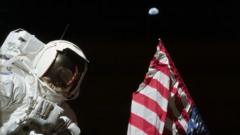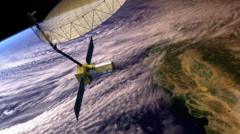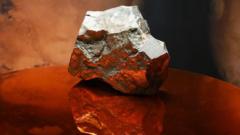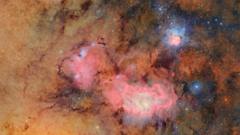At NASA's Johnson Space Center, Sierra Space develops technology to extract oxygen from lunar regolith, simulating moon-like conditions in a vacuum chamber for future lunar expeditions and sustainability.
Sierra Space Aims to Produce Oxygen on the Moon with Innovative Technology

Sierra Space Aims to Produce Oxygen on the Moon with Innovative Technology
The company tests groundbreaking systems to convert lunar soil into vital resources for future space missions.
Inside an immense chamber designed to replicate the conditions of the moon, engineers from Sierra Space are engaged in an ambitious project to create oxygen from lunar soil. Before initiating the experiment, the team meticulously operated a metallic apparatus adorned with a variety of wires, anticipating its future role in extraterrestrial oxygen production.
When they departed the test sphere, the machine began its operation, taking in small amounts of a simulated lunar regolith—an abrasive mix closely resembling the moon’s surface. The test continued as the regolith was heated to over 1,650 degrees Celsius. As specific reactants were introduced, oxygen-rich molecules began to form and escape the mass.
“We’ve conducted extensive tests here on Earth,” stated Brant White, program manager at Sierra Space. “Now, our focus shifts to the moon for the next phase.” The experiment unfolded during the summer at NASA's Johnson Space Center, where scientists are actively developing technologies to support future lunar habitats.
As astronauts lay the groundwork for a permanent moon base, oxygen will be essential not only for respiration but also for rocket fuel production destined for deeper space exploration, potentially leading to Mars and beyond. On top of oxygen, there’s significant potential to extract metals from the lunar regolith, which could be harnessed for use within this lunar environment.
Mr. White elaborated on the financial advantages of in-situ resource utilization, emphasizing that creating oxygen and metals on the moon could potentially save billions compared to transporting resources from Earth. However, the challenge of extracting these resources lies in the differences between Earth and lunar conditions.
The spherical chamber where Sierra Space conducted its tests was a state-of-the-art setup that mimicked the moon’s gravity and atmospheric pressure. Over the course of the project, the rugged texture of the regolith posed issues for the machinery, which had to be modified to accommodate the abrasive nature of the material.
One significant hurdle remains testing the equipment in real lunar low-gravity conditions, which might not occur until 2028 or later. Although scientists understand the principles of extracting oxygen from metal oxides, translating those techniques to lunar conditions presents unique obstacles.
A recent study by Paul Burke from Johns Hopkins University highlighted how a different oxygen extraction technique—molten regolith electrolysis—could be negatively influenced by the moon's lower gravity, complicating the separation process of oxygen bubbles generated during the operation.
Sierra Space's method, however, is based on a carbothermal process, which allows oxygen to escape more freely from the regolith without being trapped. Dr. Burke pointed out that astronauts would need the oxygen equivalent of about two or three kilograms of regolith daily, tailored to their individual needs.
For astronauts living on the lunar base, life support systems are expected to recycle exhaled oxygen, thereby limiting the volume of regolith needing processing just for basic survival. Moreover, Dr. Burke emphasized that the main functioning of oxide-extracting technologies would ultimately be directed at creating propellants for rocket launches, thereby making further space exploration feasible.
Amidst this research, Palak Patel, a PhD candidate at MIT, is exploring methods to extract both oxygen and metals from lunar dust. Aiming to reduce reliance on Earth resupply missions, her team has developed a molten regolith electrolysis system that addresses the anticipated challenges posed by low lunar gravity.
Through innovative ideas, like the use of sound waves to detach oxygen bubbles, Patel’s group is working towards producing resources on the moon itself. The potential materials that could be extracted include vital metals like iron, titanium, or lithium, contributing to autonomous construction on the moon and reducing operational limitations for future missions.
Additionally, Patel has discovered techniques to transform simulated lunar regolith into a tough, glass-like material, capable of being molded into strong bricks, providing solutions for potential construction needs on future lunar habitats. As more resources become available on the moon, the dream of sustainable living and exploration in space draws closer to reality.
















